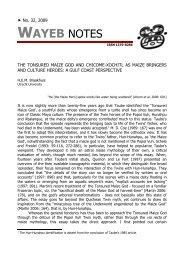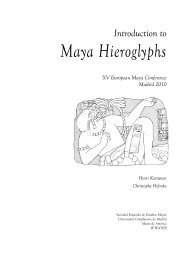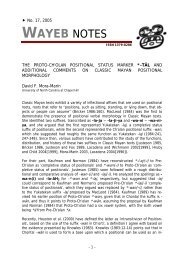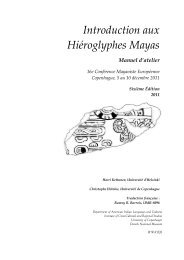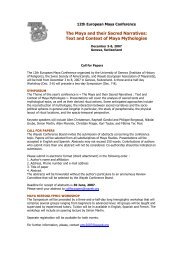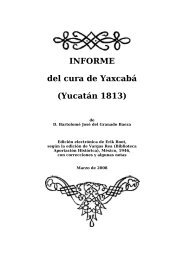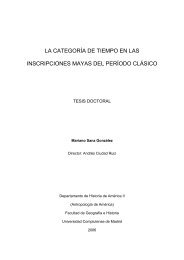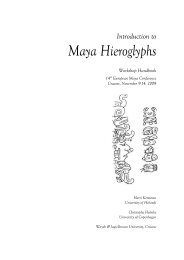Introduction to Maya Hieroglyphs - Wayeb
Introduction to Maya Hieroglyphs - Wayeb
Introduction to Maya Hieroglyphs - Wayeb
You also want an ePaper? Increase the reach of your titles
YUMPU automatically turns print PDFs into web optimized ePapers that Google loves.
Kettunen & Helmke 2011<br />
Appendices<br />
APPENDIX I: SYNHARMONIC VS. DISHARMONIC SPELLING, UNDERSPELLED SOUNDS, AND<br />
RECONSTRUCTED GLOTTAL FRICATIVES IN MAYA HIEROGLYPHIC WRITING<br />
The following is primarily based on the foundation work done by Hous<strong>to</strong>n, Robertson, and Stuart (1998, 2000),<br />
Lacadena and Wichmann (2004), and Lacadena and Zender (2001). All possible misinterpretations are ours, not<br />
theirs.<br />
EXPLANATION OF ABBREVIATIONS:<br />
C<br />
V<br />
ABS<br />
ERG<br />
consonant<br />
vowel<br />
absolutive<br />
ergative<br />
Since the pivotal study of phoneticism in <strong>Maya</strong> hieroglyphic writing by Knorozov (1952) until the latter part of<br />
1990’s, the existence of disharmony (disharmonic spelling arrangements) in the <strong>Maya</strong> script was noticed but left<br />
more or less as an open question. In 1980’s, the issue was taken under scrutiny by linguists, and some promising<br />
results were achieved.<br />
However, no overall satisfying pattern was found <strong>to</strong> explain all the arrangements until late 1990’s and during the<br />
past few years. In 1998 Hous<strong>to</strong>n, Robertson and Stuart proposed that the disharmonic spellings in the <strong>Maya</strong> script<br />
indicate the presence of preconsonantal glottal fricatives (/h/) as well as complex vowels including: long vowels<br />
(VV), glottal s<strong>to</strong>ps (’), glottalized vowels (V’) and rearticulated glottalized vowels (V’V).<br />
In their original proposal, Hous<strong>to</strong>n, Stuart, and Robertson (1998) suggested that there is no distinction made<br />
between vowel length, glottalization, and preconsonantal /h/ by means of disharmonic spellings, and that the<br />
existence of these three phonemic features are <strong>to</strong> be reconstructed his<strong>to</strong>rically:<br />
CV1C / CV1-CV1 ><br />
CV1C / CV1-CV2 ><br />
CV1C<br />
CVVC<br />
CV’C<br />
CVhC<br />
+ his<strong>to</strong>rical reconstruction<br />
A later modification by Lacadena and Wichmann (2004) pointed <strong>to</strong>ward an interpretation that complex vowels<br />
(complex syllable nuclei) “were distinguished from short vowels in the script [… and] that vowel length and<br />
glottal s<strong>to</strong>ps were clearly distinguished from one another in the orthography”. Lacadena and Wichmann (2004:<br />
103) also proposed that “neither disharmonic nor harmonic spellings indicate a preconsonantal /h/”. While the<br />
preconsonantal /h/ existed in Classic <strong>Maya</strong> (e.g. as a necessary and integral part of passive verbal constructions,<br />
see below), in the process of decipherment it must be reconstructed on the basis of his<strong>to</strong>rical linguistics.<br />
The rules governing harmonic and disharmonic spelling arrangements as modified by Lacadena and Wichmann<br />
(2004) are as follows:<br />
CV1C / CV1-CV1 > CV1C<br />
CV1C / CV1-CV2 > CVVC (V1 = a, e, o, u; V2 = i)<br />
CV1C / CV1-CV2 > CVVC (V1 = i; V2 = a)<br />
CV1C / CV1-CV2 > CV’(V)C (V1 = e, o, u; V2 = a)<br />
CV1C / CV1-CV2 > CV’(V)C (V1 = a, i; V2 = u)<br />
63/154



